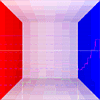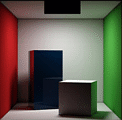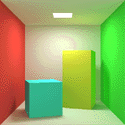|
|
History of the Cornell Box
Cornell University Program of Computer Graphics |
|
||||||||||

The Original Cornell BoxThis is the original Cornell box, as simulated by Cindy M. Goral, Kenneth E. Torrance, and Donald P. Greenberg for the 1984 paper Modeling the interaction of Light Between Diffuse Surfaces, Computer Graphics (SIGGRAPH '84 Proceedings), Vol. 18, No. 3, July 1984, pp. 213-222. Because form factors were computed analytically, no occluding objects were included inside the box.Hemicube Form FactorsThis simulation of the Cornell box was done by Michael F. Cohen and Donald P. Greenberg for the 1985 paper The Hemi-Cube, A Radiosity Solution for Complex Environments, Vol. 19, No. 3, July 1985, pp. 31-40. The hemi-cube allowed form factors to be calculated using scan conversion algorithms (which were available in hardware), and made it possible to calculate shadows from occluding objects.Spherical HarmonicsThis image was computed by Francois Sillion, et al. as part of a research into using spherical harmonics to represent Bi-directional Reflectance Distribution Functions (BRDF) for surfaces. While the previously blue right wall helped demonstrate the familiar color bleeding effects of radiosity solutions, the reflectance properties of a green wall yield more balanced solutions.Discontinuity MeshingThis simulation was computed using discontinuity meshing software developed by Dani Lischinski, Filippo Tampieri, and Donald P. Greenberg.
| ||||||||||||


